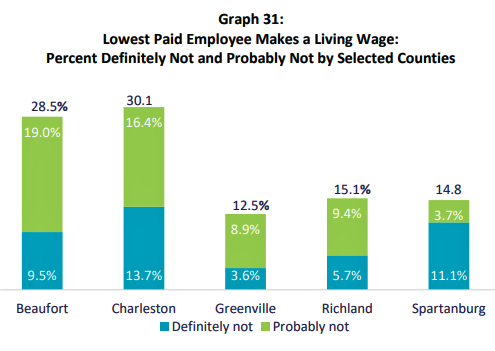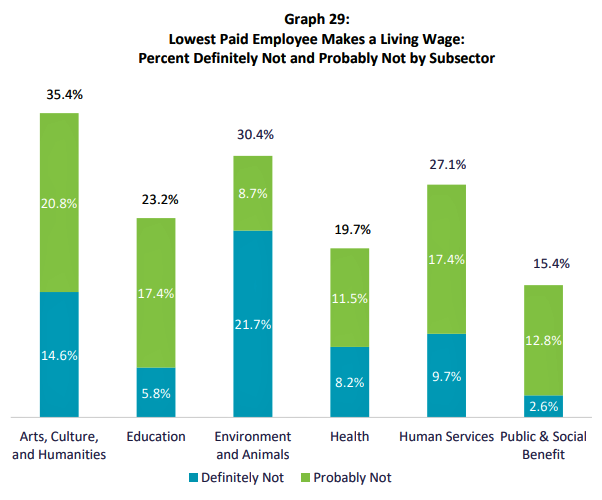South Carolina nonprofit study: Women, people of color often underpaid
Many of those who work at nonprofits in South Carolina are significantly underpaid, particularly women and people of color, according to a statewide organization that represents more than 800 nonprofits.
Together SC recently released the first nonprofit compensation study in nearly a decade. The study concluded that livable wages, racial and gender inequalities must be addressed in order for nonprofits to attract and retain staff.

Overall, findings showed that:
❯ Compensation is not always competitive.
❯ Entry-level staff are not always paid a living wage.
"Those who choose to devote themselves to a career of giving back do so for the many rewards beyond financial compensation," said Madeleine McGee, president of Together SC. "But folks have to be able to care for their own families. These findings will allow us to do more good in the community as we are able to do good by our own staff."
The nonprofit sector addresses local needs such as educational attainment, those experiencing homelessness, affordable housing, access to health care, ending violence, arts and culture, and animal and land conservation.
Nearly 500 nonprofits statewide employing one or more professional staff replied to a 70-question survey conducted by Kahle Strategic Insights of Charleston last March. In the Upstate, 105 nonprofits responded.

All 501(c)3 organizations registered in South Carolina were encouraged to participate. Surveyparticipation included both Together SC members and non-members.

"Having worked in the nonprofit sector for 20-plus years, I wasn't overly surprised by the results," said Paige Stephenson, Together SC board chair and CEO of United Way of the Piedmont. "Not-for-profit businesses are in the same talent war just as for-profit businesses, so we need to make sure we offer competitive compensation and benefits to attract and retain team members to tackle our complex community issues."

Among Upstate nonprofits participating in the study are Find Great People of Greenville, the Greenville Partnership for Philanthropy and Jolley Foundation, Spartanburg County Foundation, Spartanburg Regional Foundation, Mary Black Foundation, United Way of the Piedmont and Chapman Cultural Center.
Spartanburg celebrates nonprofitsSpartanburg Gives Brew Good 2022
Male leaders earn more than their female counterparts
Among statewide findings:
❯ Male leaders make more than their female counterparts by an average of $16,291, or 16.1%. Also, female executives made up 74% of the 419 executives submitting salary data.
❯ White executives make an average salary of $92,557 – $18,583 or 25.1% more than the $73,974 average salary of their colleagues of color. However, pay is equal for executives with doctorate degrees.
❯ The median pay for senior leaders of nonprofits is $76,000. That is lower than the $115,223 average of organizations statewide that are not nonprofits. It is also lower than the three states used for comparison – Colorado, North Carolina and Minnesota.
Leaders retiring could create shortage
Another issue is a potential shortage of leaders. Beaufort had the highest percentage, 33.4%, of nonprofit executive directors who plan to retire or resign in the next three years. Charleston County had the lowest expected leader turnover rate at 15.6%.
Arts sector most vulnerable during economic downturn
The lowest-paid sector on average is arts, culture and humanities, where leaders earn an average of $78,463. That sector also suffered the most during the COVID pandemic, with 23% reporting a decline in their number of employees and only 27% growing. All other sectors reported 57% to 60% of their organizations growing.
Billionaire donates $8 million locallyBillionaire philanthropist MacKenzie Scott donates $8 million to Mary Black Foundation
Dan Mayer, executive director of the Chapman Cultural Center in Spartanburg, said he has 12 full-time and several part-time employees. Several partner organizations, such as Little Theater, the Art Museum, Science Center and Ballet Spartanburg also staff their areas at the cultural center.
He said the cultural center is in good shape financially, but when it comes to fundraising, the arts sector seems to suffer the most during economic downturns.

"I am concerned that we all pay a livable wage and compensate our employees fairly," Mayer said. "(The study's findings) is something we need to be reminded of. There's clear evidence from the issues that are there. There are all kinds of ways we need to make steps in pay and diversity."
On the lower end of the pay scale, the average salary was $33,798 for volunteer coordinators; $38,842 for case managers; $39,042 for program coordinators; and $34,128 for administrative assistants.

$100 million requested for SC nonprofitsRequesting a $100 million designation to SC nonprofits from American Rescue Plan Act
According to ZipRecruiter, as of Jan 4, 2023, the average annual pay for the typical jobs category in South Carolina is $53,336 a year. That equates to $25.64 an hour, or $1,025 per week or $4,444 per month.
To address gender and race-based disparities, the report suggests posting salary and compensation ranges with every new job listing, formalizing annual cost of living and merit-based reviews, cultivating a diverse leadership pipeline and teaching organizations to conduct pay equity assessments.
"Living wages, meaningful benefits and HR policies that reduce compensation disparities by gender and race are actionable, data-based themes emerging from our survey," said survey author Bob Kahle of Kahle Strategic Insights.
Katy Smith, executive director of Greater Good Greenville, said study's such as this are necessary.
"While the findings are disappointing, we can't effectively address pay disparities by gender and race nor low pay for nonprofit employees if we don't have good data," she said. "Together SC took the lead on uncovering information to help document what many have suspected, and now it's incumbent upon all of us to take action.
"This includes donors and philanthropic foundations rethinking myths around overhead expenses at nonprofits to better pay people what their time, talent and impact are worth – and nonprofits taking simple steps to eliminate disparities, such as listing salary ranges with job postings, conducting COLA (cost of living adjustments) and merit-based annual reviews, and conducting compensation equity analyses."
This article originally appeared on Herald-Journal: SC nonprofit study: Women, people of color often underpaid

